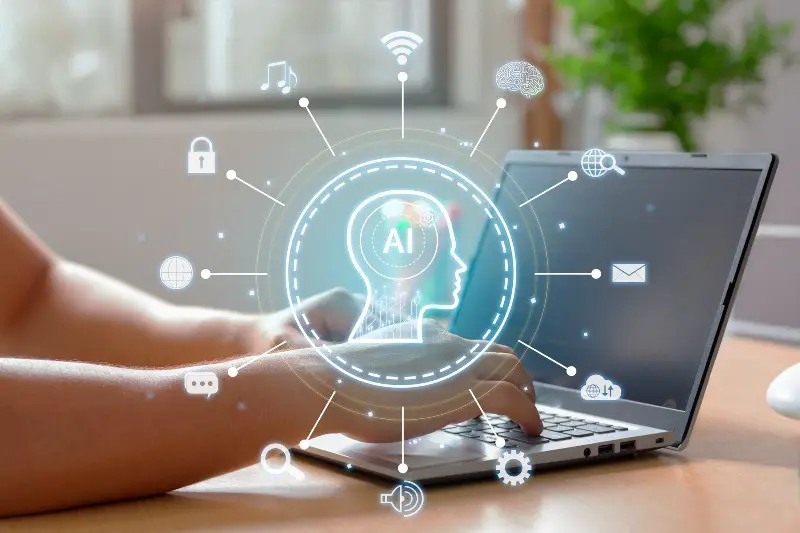The retail landscape is undergoing a dramatic transformation. Gone are the days of static displays and impersonal interactions. Today, savvy shoppers crave engaging and personalized experiences. Enter the era of Smart Retail, where Artificial Intelligence (AI) is redefining the way we shop.
A recent article in The Guardian explores the growing adoption of AI in retail. From virtual try-on experiences to intelligent product recommendations, AI is creating a more interactive and convenient shopping journey. This article delves into the world of Smart Retail experiences, exploring how AI works behind the scenes, the essential components needed for implementation, and the rigorous testing procedures that ensure success. We’ll also peek into the future, exploring exciting possibilities for AI to further revolutionize retail.
Unveiling the Magic Behind Smart Retail: How Artificial Intelligence Powers the Experience
Imagine a shopping experience that anticipates your needs, guides you effortlessly, and personalizes your journey. That’s the essence of a Smart Retail environment powered by AI. Here’s a breakdown of its core functionalities:
- Data Acquisition: The system gathers data from various sources:
- Customer Relationship Management (CRM) Systems: Purchase history and customer profiles inform product recommendations and targeted marketing.
- Sensor Networks: In-store sensors track customer movement, product interaction, and dwell time, providing valuable insights into shopping behavior.
- Camera Systems: Facial recognition and object detection technologies can be used (with customer consent) to personalize the experience and analyze customer demographics.
- AI Engine & Machine Learning: This “brain” of the system analyzes the collected data using machine learning algorithms. These algorithms learn to:
- Predict Preferences: Based on past purchases and browsing behavior, AI can recommend products relevant to each customer’s interests.
- Optimize Store Layout: Data analysis can help determine optimal product placement for better product discovery and impulse purchases.
- Enhance Security: AI-powered video analytics can detect suspicious activity and prevent shoplifting.
- Seamless Interaction: AI facilitates interaction between customers and the retail environment through various interfaces:
- Smart Displays: Interactive displays provide product information, reviews, and personalized recommendations.
- Chatbots and Virtual Assistants: These AI-powered tools can answer customer questions, assist with product selection, and streamline the checkout process.
- Augmented Reality (AR): AR apps allow customers to virtually try-on clothes or visualize furniture placement in their homes
Building the Smart Experience: Essential Components for AI-powered Retail
A well-designed Smart Retail experience requires a robust infrastructure built on several key components:
- High-performance Computing (HPC): Real-time data analysis from sensors, cameras, and customer interactions demands significant computing power.
- Secure Data Management Systems: Robust cybersecurity measures are crucial to protect customer data privacy and prevent unauthorized access.
- Omnichannel Integration: A seamless integration between online and offline channels is key for a unified shopping experience.
- User-friendly Interfaces: Interactive displays, chatbots, and AR apps should be intuitive and user-friendly for customers of all technical backgrounds.
Testing the Waters: Ensuring Functionality and Security
Before deploying a Smart Retail system, rigorous testing is paramount. Here’s what a comprehensive testing regime might involve:
- Data Security Testing: Security protocols are rigorously tested to ensure customer data is protected from breaches and unauthorized access.
- AI Model Testing: The AI model undergoes testing with real-world data to verify its accuracy in generating product recommendations, detecting customer behavior patterns, and optimizing store layouts.
- Usability Testing: The user interfaces, such as interactive displays and AR apps, are tested for ease of use, navigation, and overall customer satisfaction.
- Integration Testing: The system is tested to ensure seamless integration between its various components, including sensors, AI software, and POS systems.
Beyond the Horizon: The Future of AI in Retail
The potential applications of Artificial Intelligence in retail are vast and constantly evolving. Here are two exciting examples of how AI is shaping the future of shopping experiences:
Personalized Shopping Experiences: AI can use facial recognition and purchase history to personalize greetings, offer targeted discounts, and recommend products tailored to individual preferences. Amazon Go stores https://www.amazon.com/b?ie=UTF8&node=16008589011 leverage AI and sensor technology to create a cashierless shopping experience.
Streamlined Supply Chain Management: Artificial Intelligence can analyze sales data and customer preferences to predict demand and optimize inventory management. This reduces stockouts, minimizes waste, and ensures the right products are available at the right time. Walmart utilizes AI to forecast demand and optimize inventory levels across its vast network of stores:
These are just a couple of examples. As AI technology continues to develop, we can expect even more innovative applications in Smart Retail, such as:
- Emotion Recognition for Improved Customer Service: AI can analyze facial expressions and vocal tones to gauge customer sentiment. This allows store personnel to personalize service by offering assistance to frustrated customers or tailoring sales pitches based on customer receptiveness.
- Predictive Maintenance: AI-powered sensors can monitor equipment health in stores, predicting potential maintenance needs and preventing disruptions before they occur. This ensures a smooth shopping experience and minimizes downtime.
- Dynamic Pricing: AI can analyze market trends, competitor pricing, and customer demand in real-time to adjust product prices dynamically. This allows retailers to optimize profits while remaining competitive.
Collaboration is Key: Building a Thriving Retail Ecosystem
The successful implementation of Smart Retail experiences necessitates collaboration between various stakeholders. Here are some key areas of collaboration:
- Retailers and Technology Providers: Collaboration between retailers and AI/sensor technology companies ensures the solutions cater to the specific needs of the retail industry.
- Data Scientists and Security Experts: Collaboration between data scientists and cybersecurity experts is crucial for responsible data collection, analysis, and protection of customer privacy.
- Consumers and Regulators: Open communication with consumers regarding data usage and clear regulations on data privacy are essential for building trust in Smart Retail practices.
By fostering collaboration, addressing ethical considerations, and prioritizing customer trust, we can unlock the full potential of AI to create a thriving retail ecosystem that benefits both businesses and consumers.
Call to Action:
The future of retail is intelligent and engaging. Are you excited to see how AI will transform your shopping experience? Share your thoughts and ideas in the comments below! Let’s embrace the future of Smart Retail together.

Google Ranking Factors – Learn more about other factors
90 / 100 Google Ranking Factor – High-DA Domain A high-DA (Domain Authority) domain is a website that has a high score on Moz’s Domain

Google Ranking Factors – How to get a high DA
90 / 100 Google Ranking Factor – High-DA Domain A high-DA (Domain Authority) domain is a website that has a high score on Moz’s Domain




